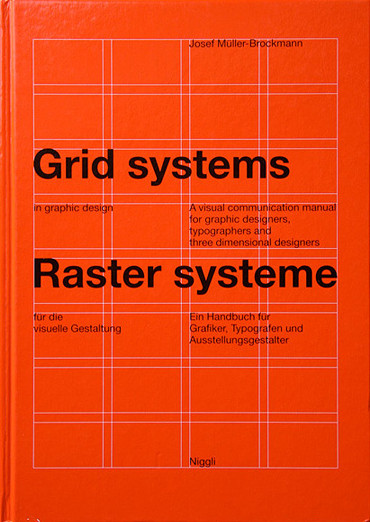Josef Müller-Brockmann: Grid Systems in Graphic Design / Raster Systeme für die Visuele Gestaltung (1968) [EN/DE]
Filed under book | Tags: · design, graphic design, typography, visual communication

This book is suitable for those who work with automated text and image design. It shows examples of working correctly on a conceptual level. Exact directions for using all of the grid systems presented (8 to 32 grid fields) are given to the user. These can be used for the most varied of projects. The three-dimensional grid is treated as well. Put simply: a guidebook from the profession for the profession.
The development of organizational systems in visual communication was the service and the accomplishment of the representatives of simple and functional typography and graphic design. In the 1920s in Europe, works already arose in the areas of typography, graphic design and photography with objectified conception and rigid composition. In 1961 a brief presentation of the grid with text and illustrations appeared for the first time in an earlier book by the author. Articles published mainly in trade journals then followed.
This book now attempts to close a gap by giving examples and exact directions to the professional concerning all grid problems that can occur. The author, a world-renowned professional, thus offers his colleagues the tools to solve problems more easily.
Grid Systems in Graphic Design: A visual communication manual for graphic designers, typographers, and three dimensional designers / Raster Systeme für die Visuele Gestaltung: Ein Handbuch für Grafiker, Typografen und Ausstellungsgestalter
Publisher Niggli Verlag, 1968
176 pages
Grid Systems in Graphic Design / Raster Systeme für die Visuele Gestaltung (English/German, 1968, no OCR)
Sistemas de retículas / Sistemas de grelhas (Spanish/Portuguese, trans. Ángel Repáraz Andrés / Fernando Peraira Cavadas, 1982, added on 2013-12-11, removed on 2017-3-9 upon request of the publisher)
Sibyl Moholy-Nagy: Moholy-Nagy – Experiment in Totality (1950–)
Filed under book | Tags: · architecture, art, art history, bauhaus, biography, constructivism, graphic design, history of architecture, painting, typography

“This biography of the Constructivist leader László Moholy-Nagy illustrates his struggle for a total approach to seeing-teaching-creating. Written by Sibyl Moholy-Nagy, László’s second wife and lifetime collaborator, she witnessed many of the defining moments of the Bauhaus movement and its migration to the United States and its continuation as the Chicago New Bauhaus and Institute of Design. An excellent first-person account.”
With an Introduction by Walter Gropius
Publisher Harper & Brothers, New York, 1950
262 pages
Second edition
Publisher MIT Press, 1969
xviii+259 pages
PDF (1950)
Internet Archive (1950, multiple formats)
PDF (2nd ed., 1969, added on 2020-1-3)
László Moholy-Nagy: The Art of Light (2010) [Spanish]
Filed under book, catalogue | Tags: · art, avant-garde, bauhaus, constructivism, film, graphic design, light art, painting, photography, sculpture, typography

An artist and thinker of astounding energy and ability, Laszlo Moholy-Nagy was a true world citizen of the early twentieth century, an ambassador-at-large for Constructivism, Suprematism, Dada and the Bauhaus. He brought the same Constructivist optimism to every medium he tackled, from plexiglass and light sculpture to typography to his photographic experiments in color to his Suprematist canvases, his influential pedagogy at the Bauhaus and at the Institute of Design in Chicago. Moholy-Nagy’s concept of the arts as a totality, his pedagogy and his confidence in the new industrial culture that would level distinctions between art and craft led him into all fields of creative production. The ultimate modernist Renaissance man, Moholy-Nagy was prolific in so many realms that his detractors inevitably charged him with dilettantism. This accusation ignores his very real innovations in photography–for example his photograms–and light sculpture, as well as the fact that the artist’s aims possessed a conceptual unity in their common aspiration to make an “art of light.”
László Moholy-Nagy: The Art of Light presents Moholy-Nagy’s work in all of its glorious unity and diversity. Including more than 200 works, from painting, photography (black and white and color) and photograms to collages, films and graphic design, it emphasizes his greatest years of productivity, from 1922 to the end of his life. The Art of Light is the new definitive volume on this hero of modernism.
László Moholy-Nagy: El Arte de la Luz
Book coordination: Doménico Chiappe, Luisa Lucuix
Editor: Emilio Ruiz Mateo
Publisher: La Fábrica Editorial / Círculo de Bellas Artes, Madrid
ISBN: 8492841257, 9788492841424
264 pages
exhibition (Madrid, 2010)
Comment (0)
